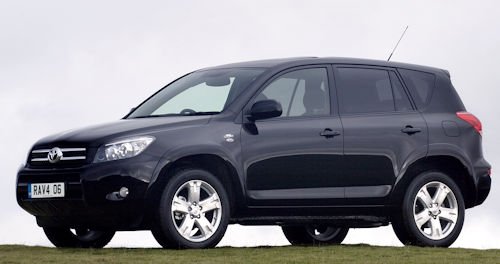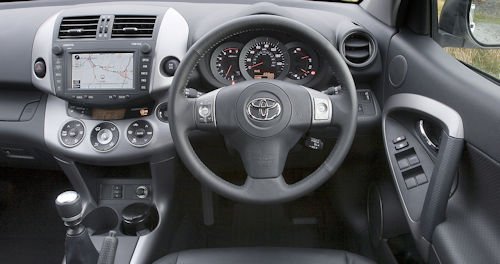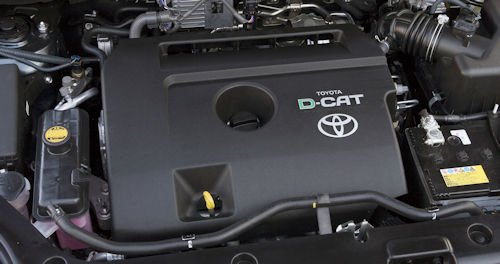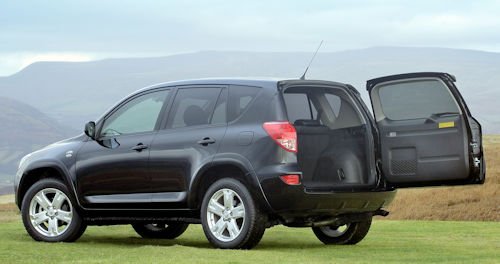Toyota RAV4 Third generation
 |
|
|
Model code |
XA30 |
|
Production |
2006 to 2016 |
|
Body style |
5-door SUV |
|
Platform |
Toyota New MC platform |
|
Engine |
|
|
Transmission |
|
|
Wheelbase |
2,560–2,660 mm (100.8–104.7 in) |
|
Length |
4,395–4,620 mm (173.0–181.9 in) |
|
Width |
1,815–1,855 mm (71.5–73.0 in) |
|
Height |
1,685–1,755 mm (66.3–69.1 in) |
In March 2006, the third RAV4 appeared. The body grew compared to the second generation by up to 12 cm in the outer length. For the first time, the RAV4 was available exclusively as a five-door. A version with pure front-wheel drive was no longer offered due to lack of public interest. The vehicle is equipped with an all-wheel drive system (Active Torque Control), which uses an electromagnetically controlled clutch. The torque distribution between the front and rear axles is continuously optimized while driving. The RAV4 is available in four grades: XT3, XT4, XT5 and T180.
The RAV4 has been totally redesigned, taking into account modern customer expectations, while retaining the fun-to-drive quality that has been fundamental to its lasting appeal. It’s longer and wider than the previous model, providing more cabin space for passenger comfort and also a substantial – 47 per cent – increase in load area volume. Action is all that’s needed to do the job – headrests and the seat cushions can be left in place. Numerous handy storage spaces have been created throughout the vehicle, including a generously-sized underfloor compartment in the boot.
In addition, vehicle dynamics regulations such as VSC + (Vehicle Stability Control) of the latest generation were installed, which Toyota calls in the entirety IADS (Intelligent Active Drive System). For example, the systems are able to detect oversteer or understeer tendencies of the vehicle and to actively assist the driver in correct steering reactions or to impede incorrect steering reactions. The system monitors and controls all active safety systems such as ABS, brake assistant, TRC (Traction Control, traction control system), VSC + and the electronic power steering.
Aerodynamic design gives the RAV4 a drag coefficient of 0.31Cd, the best in its segment. Smooth airflow around the car aids fuel consumption, quiet running at high speed and stability.
The vehicle is 145mm longer than the previous generation model at 4,395mm (4,315 for T180 without rear-mounted spare wheel) and has a significantly longer wheelbase (+70mm) and rear overhang. This allows passenger comfort to be greatly improved: cabin length is up by 85mm (to 1,820mm) and the couple distance between front and rear seats is greater by 55mm.Interior volume is now 3,822 litres, an increase of 13 per cent on the outgoing model. The benefit of this is most evident in the luggage compartment, the rear passenger headroom and the shoulder room for all occupants. Load capacity is 586 litres with the seats in place, growing to 1,469 litres when the rear seats are folded down.

KEY POINTS
- All-new RAV4, third generation of the world’s most successful compact SUV
- Establishing new benchmarks for driving performance, quality, passenger comfort and equipment
- Rugged and modern five-door body
- Longer and wider than previous model, but easier to manoeuvre
- Class-leading aerodynamics for improved fuel efficiency
- Significant increase in interior space, including 47 per cent more luggage room
- Toyota Easy Flat folding rear seat system
- Active Torque Control 4WD system automatically transfers torque between front and rear wheels for optimum performance in all conditions
- First-in-segment Integrated Active Drive System (XT4 grade and higher)
- Hill-start Assist Control (HAC) – standard on XT4 grade and higher, plus Downhill Assist Control (DAC) on models with automatic transmission
- All-new suspension for improved ride and comfort
- Three engines – revised 2.0-litre VVT-i petrol and new-to-the-range 2.2-litre D-4D 140 and 180 diesels
- 175bhp (177 DIN hp) 2.2-litre D-4D 180 engine exclusive to flagship T180 model
- D-4D 180 most powerful engine in its class, with nought to 62mph in 9.3 seconds and 40.4mpg combined cycle fuel consumption
- Four trim levels – XT3, XT4, XT5 and T180
- Alloy wheels, air conditioning, sound system with CD player and MP3/WMA compatibility, Easy Flat folding rear seat system and remote central double locking and alarm standard on all models
- Leather upholstery, glovebox cooler, sunroof and climate control standard on XT4; full map colour satellite navigation, Bluetooth connectivity, Smart entry and Smart start system standard on XT5; rear privacy glass, 18-inch alloys and wheelarch extensions standard on T180
- Nine airbags, including first-in-class driver’s knee airbag, standard on all models
- Flagship T180 equipped with run-flat tyres and tyre pressure monitoring system, hence no tailgate-mounted spare wheel
The spare wheel is in the highest trim level in conjunction with the 130-kW diesel no longer exists, as these tires with emergency running features (Run Flat Tire), at least 80 kilometres the way to a garage at reduced speed (80 km / h) enable.
The following engines are offered:
- 2.0-liter 4-cylinder gasoline engine with 112 kW (152 hp) (VVTi)
- 2.2-liter 4-cylinder diesel engine with 100 kW (136 hp) (D-4D)
- 2.2-liter 4-cylinder diesel engine with 130 kW (177 hp) (D-CAT)
New era engines
Two of Toyota’s new generation 2.2-litre D-4D common rail diesel engines are offered in the RAV4 for the first time.
The D-4D 180, with 175bhp (177 DIN hp) and nought to 62mph acceleration in 9.3 seconds, is the most powerful engine in its class, yet will return 40.4mpg in combined cycle driving. Notably fuel economy and emissions levels are better than for the previous generation RAV4’s 2.0-litre D-4D engine.
The D-4D 80 will be available exclusively in the new RAV4 flagship model, the T180. The volume diesel power unit is the D-4D 140, delivering 134bhp (136 DIN hp), nought to 62mph in 10.5 seconds and 42.8mpg (combined).
Both engines have lightweight all-aluminium construction and benefit from engineering advances to achieve new low levels of noise and vibration. Low compression ratios and, in the D-4D 180, the use of piezoelectric fuel injectors, contribute to the excellent economy and low exhaust emissions. Toyota D-CAT (Diesel - Clean Advanced Technology) applied to the D-4D 180, including the unique DPNR four-way catalyst system, gives the engine world-
What’s more, the interior is more flexible than ever before with the adoption of Toyota’s Easy Flat system, which allows the rear seats (split 60:40) to be folded flat into the vehicle floor. A single lever

Model maintenance
In February 2009, the RAV4 was given a facelift. The front end, rear and sills were optically altered. The interior has also been slightly modified. Contrary to expectations, Toyota now offers a version with pure front-wheel drive (4x2) in the revised RAV4. The front-wheel drive is only available with gasoline engine and can only be ordered with 6-speed manual transmission.
The four-wheel drive version of the gasoline engine is available with the new continuously variable automatic transmission (Multidrive-S).
The RAV4 is also the first vehicle in its segment to offer Integrated Active Drive. This combines and coordinates the Active Torque Control 4WD, the Vehicle Stability Control Plus (VSC+) and Electric Power Steering (EPS) to help bring the vehicle under control if the onset of a skid or slide is detected. This provides much smoother and more effective intervention to help the driver keep control than in vehicles where the functions operate independently of each other.
Further aids newly available for safe progress include Hill-start Assist Control (HAC), which prevents the vehicle from slipping backwards when pulling away on an uphill gradient, and, on models with automatic transmission, Downhill Assist Control (DAC), which automatically applies braking pressure on steep descents without the wheels locking.
The RAV4 benefits from new suspension designs with MacPherson struts at the front and double wishbones at the rear. The new rear system is unique to the RAV4 and features diagonally-mounted shock absorbers positioned beneath the boot floor, causing less intrusion in the load space.
For the 110-kW diesel is now optionally a 6-speed automatic to have.
Since September 2009, the diesel version with 110 kW (150 hp) is also offered as a front-wheel drive (4x2) with 6-speed manual transmission.
The engines:
- 2.0-liter 4-cylinder gasoline engine with 116 kW (158 hp) (VVT-i Valvematic)
- 2.2-liter 4-cylinder diesel engine with 110 kW (150 hp) (D-4D)
- 2.2-liter 4-cylinder diesel engine with 130 kW (177 hp) (D-CAT)
In April 2010, the RAV4 was revised again. The entire front including bonnet, headlights, grille and fog lights and front apron were modified.
In early 2013, production of the third generation ended in Europe and Japan by 2016.

Technical
-
Specifications and Equipment
ENGINE 2.0-litre VVT-i
Type
Four cylinders in-line
Cylinder head material
Aluminium
Engine block material
Aluminium
Valve mechanism
Variable Valve Timing – intelligent,
16-valve, DOHC, chain drive
Fuel system
Electronic fuel injection
Bore x stroke (mm)
86.0 x 86.0
Displacement (cc)
1,998
Compression ratio
9.8:1
Max. power [bhp (DIN hp) /rpm]
150 (152) @ 6,000
Max. torque (Nm/rpm)
194 @ 4,000
ENGINE D-4D 140
Type
Four cylinders in-line
Cylinder head material
Aluminium
Engine block material
Aluminium
Valve mechanism
16-valve, DOHC, chain drive
Fuel system
Common rail with solenoid injectors
Injection pressure (bar)
1,700
Bore x stroke (mm)
86.0 x 96.0
Displacement (cc)
2,231
Compression ratio
16.8 :1
Max. power [bhp (DIN hp) /rpm]
134 (136) @ 3,600
Max torque (Nm/ rpm)
310 @ 2,000-2,800
ENGINE D-4D 180
Type
Four cylinders in-line
Valve mechanism
16-valve, DOHC, chain drive
Cylinder head material
Aluminium
Engine block material
Aluminium
Fuel system
Common rail with piezoelectric injectors
Injection pressure (bar)
1,800
Bore x stroke (mm)
86.0 x 96.0
Displacement (cc)
2,231
Compression ratio
15.8 :1
Max. power (bhp (DIN hp) /rpm)
175 (177) @ 3,600
Max torque (Nm/ rpm)
400 @ 2,000-2,600
PERFORMANCE
2.0 VVT-i
(5 M/T)
2.0 VVT-i
(4 A/T)
D-4D 140
(6 M/T)
D-4D 180
(6 M/T)
Max. speed (mph)
115
109
112
124
0-62mph (sec)
10.6
12.0
10.5
9.3
FUEL CONSUMPTION, EMISSIONS & VED RATING
Combined (mpg)
32.8
31.4
42.8
40.4
Urban (mpg)
25.7
24.4
34.9
33.6
Extra Urban (mpg)
39.2
38.2
50.4
46.3
Fuel tank capacity (l/gal)
60 /13.2
CO2 (g/km, combined cycle)
202
212
173
185
Carbon monoxide – CO (g/km)
0.39
0.27
0.16
0.12
Hydrocarbons – HC (g/km)
0.04
0.04
-
-
Nitrogen oxides – NOx (g/km)
0.02
0.04
0.22
0.13
HC + NOx (g/km)
-
-
0.23
0.14
Particulate matter – PM (g/km)
-
-
0.016
0.003
VED Rating
F
F
E
E
SUSPENSION
Front
MacPherson strut
Rear
Double wishbone
BRAKES
Front (mm)
Ventilated discs (Ø296 x 28)
Rear (mm)
Solid discs (Ø281 x 12)
Additional features
ABS, Electronic Brakeforce Distribution, Brake Assist. Downhill Assist Control (A/T models only), Hill start Assist Control, VSC+, Traction Control, Integrated Active Drive System on XT4 models and above.
STEERING
2.0 VVT-i & D-4D 140
D-4D 180
Type
Rack and pinion, Electric Power Steering
Ratio (:1)
14.4
14.6
Turns lock to lock
2.8
2.7
Min. turning radius – tyre (m)
5.1
5.4
TYRES AND WHEELS
2.0 VVT-i & D-4D 140
D-4D 180
Wheel size
17 x 7J alloy
18 x 7.5J alloy
Tyre size
225/65 R17
235/55 R18 run-flat
WEIGHTS
2.0 VVT-i
(5 M/T)
2.0 VVT-i
(4 A/T)
D-4D 140
(6 M/T)
D-4D 180
(6 M/T)
Kerb weight (kg)
1,465
1,505
1,585
1,595
Towing capacity (unbraked) kg
750
750
750
750
Towing capacity (braked) kg
1,500
1,500
2,000
2,000
Gross Vehicle Weight (kg)
2,070
2,110
2,190
2,190
TRANSMISSION
Type
Electronically-controlled 4WD
Clutch type
Dry, single plate
GEAR RATIOS
2.0 VVT-i
(5 M/T)
2.0 VVT-i
(4 A/T)
D-4D 140 & D-4D 180
(6 M/T)
1st
3.833
3.938
3.818
2nd
2.045
2.194
1.913
3rd
1.333
1.411
1.218
4th
1.028
1.019
0.880
5th
0.820
-
0.809
6th
-
-
0.711
Reverse
3.583
3.141
4.139
Final drive ratio (f/r)
4.562/
2.277
3.291/
2.277
4.312 (1st-4th) 3.631
(5th-6th)/2.277
DIMENSIONS - EXTERIOR
Overall length (mm)
4,395 (4,315 T180)
Overall width (mm)
1,815 (1,855 T180)
Overall height (mm)
1,685 (1,720 with roof rails)
Wheelbase (mm)
2,560
Tread width – front (mm)
1,560
Tread width – rear (mm)
1,560
Front overhang (mm)
860
Rear overhang (mm)
975 (895 T180)
Coefficient of drag
0.31
DIMENSIONS – INTERIOR
Interior length (mm)
1,820
Interior width (mm)
1,495
Interior height
1,240 (1,165 with sunroof)
DIMENSIONS – LUGGAGE COMPARTMENT
Capacity – seats in place (l)
586
Capacity – seats folded (l)
1,469
Load area length (mm)
800 (1,500 with seats folded)
Load area width (mm)
1,335
Load area height (mm)
995
OFFROAD PERFORMANCE
Approach angle (°)
25
Ramp angle (°)
20
Departure angle (°)
20
Running clearance (mm)
200
Front axle clearance (mm)
180
Rear axle clearance (mm)
180
© Motor car History
